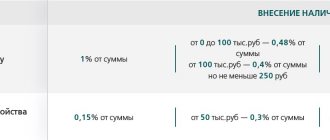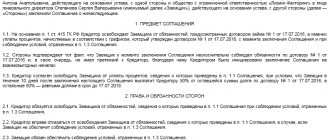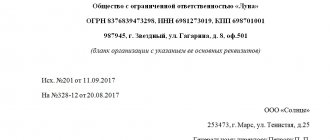Basic Concepts
Lending is considered an important area of activity in which not only banks, but also other organizations operate. Often different companies need a free amount of money, but at the same time, applying for a standard loan is considered an impractical solution. Therefore, an interest-free loan agreement between legal entities is used. When using it, you do not need to pay interest or fees for using money.
Even when using such a loan, a certain participant has a material benefit. Therefore, it is important to correctly reflect the implementation of this operation in the financial statements. A company that makes a profit must pay taxes, otherwise it will have problems with the tax authorities.
Loan concept
An interest-free loan between legal entities is the process of providing a certain amount of money from one organization to another company free of charge. This money does not pay interest or fees.
Using such a loan, the borrower receives material benefits in the form of savings on interest.
When using an interest-free loan between legal entities, the agreement specifies the basic conditions that must be observed by each party to the transaction. If there are violations, they are resolved through the courts.
There is no material benefit if the funds are used to purchase residential real estate or build a house. This also includes the situation when a company representative issues a tax deduction for the purchased object.
Tax consequences for loans from related parties
Interest-free loans between interdependent Russian organizations and citizens do not affect income tax. The lender recognizes neither income nor expenses. The borrower does not have savings on interest (Letter of the Ministry of Finance dated March 23, 2017 N 03-03-РЗ/16846).
Interest-bearing loans can be controlled transactions, but in very rare cases. For example, when the annual amount of income from transactions with an interdependent borrower using the simplified tax system is more than 60 million rubles. The Federal Tax Service must be notified about such loans.
If the interest on a controlled loan is less than 75% of the refinancing rate, the lender must recognize in income interest accrued not at the actual rate, but at the market rate (clause 1.1 of Article 269 of the Tax Code of the Russian Federation).
Interest on non-controllable loans is accounted for by related parties as usual. The borrower fully includes them as expenses, and the lender recognizes income. Personal income tax on financial benefits for loans issued to interdependent individuals is calculated in the general manner.
Letter of the Ministry of Finance dated March 23, 2017 N 03-03-RZ/16846
Question : About income tax when providing (receiving) an interest-free loan.
Answer:
MINISTRY OF FINANCE OF THE RUSSIAN FEDERATION
LETTER dated March 23, 2022 N 03-03-RZ/16846
The Department of Tax and Customs Policy reports the following.
Paragraph 1 of Article 269 of the Tax Code of the Russian Federation (hereinafter referred to as the Code) establishes that for debt obligations of any type, income (expense) is interest calculated based on the actual rate, unless otherwise established by Article 269 of the Code.
For debt obligations of any type arising as a result of transactions recognized as controlled transactions in accordance with this Code, income (expense) is recognized as interest calculated based on the actual rate taking into account the provisions of Section V.1 of the Code, unless otherwise established by Article 269 of the Code (paragraph third paragraph 1 of Article 269 of the Code).
Thus, according to paragraphs one through three of paragraph 1.1 of Article 269 of the Code, for a debt obligation arising as a result of a transaction recognized as a controlled transaction in accordance with the Code, the taxpayer has the right:
- recognize as income interest calculated on the basis of the actual rate on such debt obligations, if this rate exceeds the minimum value of the interval of limit values established by paragraph 1.2 of Article 269 of the Code;
- recognize as an expense interest calculated on the basis of the actual rate on such debt obligations, if this rate is less than the maximum value of the interval of limit values established by paragraph 1.2 of Article 269 of the Code.
If the conditions established by paragraphs one through three of clause 1.1 of Article 269 of the Code are not met, for debt obligations arising as a result of transactions recognized as controlled transactions in accordance with the Code, interest calculated on the basis of the actual rate taking into account the provisions of Section V is recognized as income (expense). 1 of the Code.
It should be noted that from 01.01.2017, transactions for the provision of interest-free loans between related parties, the place of registration or place of residence of all parties and beneficiaries in which is the Russian Federation, regardless of whether such transactions satisfy the conditions provided for in paragraphs 1 - 3 of Article 105.14 Code are not recognized as controlled (subclause 7 of clause 4 of Article 105.14 of the Code). Thus, in the event of a transaction to provide (receive) an interest-free loan (based on a 0 percent rate) that is not recognized as controlled in accordance with the Code, the provisions of paragraph three of paragraph 1 and paragraph 1.1 of Article 269 of the Code do not apply.
As for income from interest-free use of borrowed funds, it should be noted that in accordance with Article 41 of the Code, income is recognized as economic benefit in monetary or in-kind form, taken into account if it is possible to evaluate it and to the extent that such benefit can be assessed, and determined in accordance with the chapters “Tax on personal income”, “Tax on corporate income” of the Code.
The procedure for determining material benefit and its assessment when receiving an interest-free loan is not established in Chapter 25 “Organizational Income Tax” of the Code.
Consequently, the material benefit received by an organization from the interest-free use of borrowed funds does not increase the tax base for corporate income tax.
Director of the Department A.V. SAZANOV 03/23/2017
Rules for drawing up a contract
If the funds are transferred free of charge, then the interest-free loan agreement between legal entities will certainly be drawn up correctly. Their training takes into account numerous requirements. There is no specific form strictly established by law, so a free form can be used.
The document is drawn up only in written form. Its obligatory condition is the absence of accrued interest and commissions. An example of an interest-free loan agreement between legal entities can be studied below.
The basic rules for the formation of this document include the following:
- this is done exclusively in writing;
- signed by both parties to the agreement;
- since the parties to the contract are companies, they certify the signing of the document with seals;
- if the object of the transaction is a sum of money, then it is expressly established that interest is not accrued on it, otherwise both participants will have unpleasant tax consequences;
- if property is transferred on the basis of a document, then no special instructions are required, therefore, by default, such an agreement is considered interest-free;
- if an amount exceeding 600 thousand rubles is provided, then such an agreement must be registered with government agencies.
Only by taking these facts into account can an agreement be drawn up correctly.
How to reduce risks
As we can see, loans between interdependent legal entities, especially interest-free ones, can have serious tax consequences. If the court recognizes the borrowing relationship as fictitious, this may lead, in particular, to additional assessment of income tax and personal income tax. Moreover, even if the borrower actually pays interest on the loan, this does not guarantee that the loan will not be re-qualified. How to minimize risks?
Avoid loans on non-market terms
Loans must comply with market conditions both “de jure” and “de facto”. This means that when formalizing a loan relationship between “friends,” it is not enough to include in the agreement the same conditions as in agreements with unaffiliated persons. It is also necessary to actually confirm the reality of the transaction. And to do this, monitor the execution of contracts and demand a refund at the end of the loan term. Also, you should not issue loans without collateral or renew contracts if you know that the borrower is in poor financial condition.
Return money from formal loans
We advise you to conduct an audit of existing borrowing relationships and evaluate them from the point of view of signs of formality. And if such signs are detected, then it is worth taking measures to return the funds in order to reduce the risk of loan recharacterization and additional tax charges.
Essential conditions
When drafting this contract, some basic terms must be included. Additional information is agreed upon by the two participants in the cooperation. By law, the contract must include the following terms:
- a direct indication that the loan provided does not accrue interest;
- the amount of money transferred is indicated, which should not exceed 50 times the minimum wage;
- the transfer of money should not be related to business activities;
- the method of transferring money is indicated, since it can be issued in cash or transferred to the company’s account;
- indicates the exact date on which the borrower must return the money or other item.
Based on Art. 809 of the Civil Code, such an agreement can be concluded not only when transferring funds, but also when providing a certain thing that has certain generic characteristics.
Other terms in the contract may vary significantly depending on different situations. The important point is that each participant is endowed with certain rights and responsibilities that must be strictly observed. Therefore, if the recipient of the money fails to repay the money within the prescribed period, he will face numerous negative consequences of an interest-free loan between legal entities. The main negative point is the possibility of confiscation and sale of your property. The funds received from this process are sent to the creditor to pay off the debt.
Nuances of forming a contract
An interest-free loan between legal entities will be issued correctly only if there is a correctly drawn up agreement. When forming it, the following features are taken into account:
- the parties cannot be interdependent, otherwise they may attract the attention of tax inspectors or employees of other government bodies to such an agreement;
- the standard contract contains essential and additional conditions;
- in the absence of important conditions, such a transaction will be considered invalid;
- indicate the full name of both companies participating in the transaction;
- lists the rights and obligations that companies have after signing such an agreement;
- the responsibility of each party in case of violation of the existing terms of the contract is given;
- it prescribes the ways in which companies can solve emerging problems or force majeure circumstances, and it is also usually indicated that representatives of organizations should initially try to resolve problems peacefully, and only then go to court;
- the reasons for early termination of the contract are indicated.
If the contract is drawn up correctly, indicating important information, then this document will not attract the attention of the competent authorities. Only on the basis of such a document are interest-free loans issued between legal entities. Below is a sample agreement.
Amount restrictions
There are no legal requirements or restrictions on the amount one company can lend to another company. It is determined solely by agreement of the parties. But at the same time, there are some requirements for the money transfer process, which can be carried out both in cash and non-cash. The taxation of interest-free loans between legal entities depends on this. Therefore, the following rules are taken into account:
- if the transaction involves paying money in cash at the organization’s cash desk, then it is impossible to use more than 100 thousand rubles under the agreement at a time;
- if the borrower needs money above 100 thousand rubles, then it is necessary to draw up several contracts or transfer funds in non-cash form;
- if a non-cash method of transferring money is used, then if the amount is more than 600 thousand rubles, the signed agreement must be registered.
In case of non-compliance with the above conditions, an inspection will be carried out in relation to both parties to the transaction. This may result in organizations being held accountable for identified violations.
Is there any material benefit?
Each participant in the transaction must take into account the tax consequences of an interest-free loan between legal entities. The company, which receives money for its use without interest, derives some benefit from this process. Therefore, the company must take into account the profit received when calculating the taxable base for income tax.
An accountant must competently understand how this material benefit is calculated correctly. Since the interest rate is not specified in the agreement, the Central Bank refinancing rate is used in the calculation.
The material benefit is calculated using the formula: material benefit = refinancing rate * 2 / 3 * debt amount / 365 * loan term in days. The resulting value is included in the tax base necessary for calculating income tax. The settlement procedure will be carried out on the day the loan amount is fully repaid to the lender. This does not take into account the method of payment of the debt, so the amount can be paid in installments or in a single payment at the end of the period specified in the contract.
If the tax on the amount received is not paid, the tax inspector may hold the company liable. This risk of interest-free inter-entity lending must be considered by every organization.
Loan agreement between interdependent organizations
Let us recall that organizations are recognized as interdependent according to those listed in paragraph 2 of Art. 105.1 of the Tax Code of the Russian Federation on the grounds:
- when one of the organizations participates in the capital of the other by more than 25%;
- when one company owns more than half the capital of a second organization, that, in turn, owns most of the capital of a third organization, etc.;
- if in different organizations the same individuals are included in the management team of the company;
- if in different organizations one person is a leader.
The interdependence of legal entities may be recognized on other grounds if, due to special relations, this affects the terms of transactions between them (Clause 2 of Article 105.1 of the Tax Code of the Russian Federation).
According to the conditions specified in the agreement, a loan agreement concluded by legal entities, if they are interdependent, can be:
- compensated, when one company pays another not only the loan amount, but also interest for using the money,
- gratuitous - when in order to fulfill the obligation it is enough to return to the lender only the amount of the loan itself, no interest is accrued.
It should be taken into account that loans between interdependent legal entities may be classified as controlled transactions if they have at least one of the characteristics listed in paragraphs. 2-3 tbsp. 105.14 Tax Code of the Russian Federation.
Taxation of participants in a transaction
Every company accountant should know how to properly arrange an interest-free loan between legal entities. Taxes are paid exclusively by the party that has received material benefits from this process.
A company that lends money without interest makes no profit, so it has no tax consequences.
The borrower benefits from the absence of interest, so the benefit is calculated based on the refinance rate, after which it is added to the income tax base.
According to Art. 25 of the Tax Code of the Russian Federation, many companies try to prove through the courts that there is no need to pay taxes. To do this, they turn to the arbitration court. In judicial practice, there are indeed cases when the court satisfied the plaintiffs’ demands, due to which the borrowers were exempt from paying taxes, but in most cases, representatives of the Federal Tax Service proved that the company had a material benefit.
Controlled transactions
The legislation includes the concept of “controlled transactions”; they are listed in Article 105.14 of the Tax Code of the Russian Federation. And Article 105.16 of the Code states that the tax service must be notified of such transactions. However, will any transaction between related parties be considered controlled? Not at all. Transactions that affect the tax base for taxes on corporate profits, mineral extraction, personal income tax of citizens with individual entrepreneur status, as well as VAT may be considered controlled. Moreover, with regard to the latter tax, the following condition is specified: one of the parties to the transaction is not its payer or applies an exemption from its payment. These are the requirements of paragraph 11 of Article 105.14 and paragraph 13 of Article 105.3 of the Tax Code of the Russian Federation.
In general, if we talk about relationships with Russian dependent parties, then most transactions with them will not be classified as controlled. But this does not mean at all that they will fall out of the field of view of the Federal Tax Service.
Errors when drawing up a document
It is important to correctly draw up an interest-free loan agreement between legal entities. The founders check the correctness of the document, since if there are errors in it, this may become a basis for challenging it.
The most common mistakes:
- there is no clause stating that the loan is interest-free, which means that even the lender will have to calculate and pay income tax, since Federal Tax Service employees will ensure that the company receives interest;
- the exact date on which the funds must be returned is not specified, which creates difficulties in the process of debt collection;
- the parties to the transaction are interdependent persons, so each party has tax risks.
To avoid errors in such a complex and specific agreement, it is recommended to use the help of a lawyer in the process of drawing it up.
Interest-free loan between interdependent legal entities
Interest-free loans between legal entities make it easy to redistribute finances within a group of companies. Issuing such loans to interdependent legal entities is quite acceptable, but even interest-free loans can entail tax risks - additional income tax.
The taxable income of the lender under a gratuitous agreement is determined by the amount of interest that he theoretically could receive by concluding a loan agreement with those who are not interdependent in relation to him, i.e., in the so-called “comparable” transaction (clause 1 of Art. 105.3 of the Tax Code of the Russian Federation). As we can see, even an interest-free loan between interdependent persons creates income subject to income tax for the lending organization.
For the borrowing organization, receiving an interest-free loan does not generate income, and the material benefit received from using borrowed money does not increase the tax base (letter of the Ministry of Finance of the Russian Federation dated 02/09/2015 No. 03-03-06/1/5149).
If an organization takes out a bank loan, which it then transfers in the form of an interest-free loan to another holding organization, tax authorities may consider the tax benefit received to be unjustified, but arbitration decisions that are positive for taxpayers are possible if it turns out that such a redistribution of funds did not contradict tax legislation (for example, a resolution of the AS SZO dated July 1, 2015 No. A56-60966/2014).
You can find more complete information on the topic in ConsultantPlus. Free trial access to the system for 2 days.
Can an individual entrepreneur be a participant?
Individual entrepreneurs are not legal entities, therefore, when drawing up various agreements with them, you should use the rules applicable to citizens. Entrepreneurs as individuals are required to pay personal income tax, therefore, when receiving an interest-free loan from another company, a citizen has an economic benefit due to the absence of interest.
This benefit is calculated as 2/3 of the refinancing rate, after which the resulting value is multiplied by the amount received. The calculated indicator is divided by 365 days and multiplied by the number of days during which the entrepreneur can use the borrowed amount.
As a result of the calculation, a tax base is obtained, from which 13% is paid.




